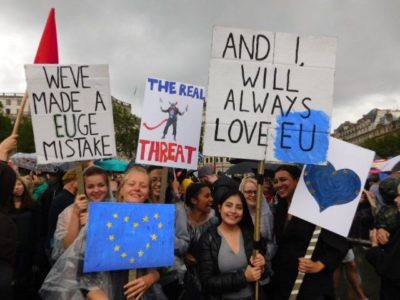Who are we?
British researchers are leading the way to define Europe’s new political cleavages

Protest against Brexit
Political scientists have plunged into a deep crisis when they realized, the good old days of classic political cleavages are over. The Brexit referendum and the US presidential elections have been the last confirmation of this phenomenon. We have officially left behind a plausible narrative to explain voter’s behaviour. The agony of social-democrats all over Europe states this case particularly well. They can’t define anymore their target group – nor the policies to win over their hearts.
However, experts seem to have recovered from the shock by now, and started to work on new theories to explain Europe’s political landscape. In an ironic way, British researchers came out with new ideas first.
I especially liked David Godheart’s “The Road to Somewhere: The Populist Revolt and the Future of Politics” published this spring, because the book highlighted the motivations laying behind voting in favour or against leaving the EU in a different way. Godheart argues that the vote reflected the people’s answer on the question whether Britain feels like a foreign country by now. As the author explains, a bit more than 50% of the British population can be considered as “Somewheres”, whose identity is rooted in belonging to a specific place or community, while the 25% of “Anywheres” are able to make their life at any place and draw their confidence and identity on their achievements (the remaining 25% is called “Inbetweeners” according to Godheart’s theory). Consequently, the difference between these groups can’t only be explained only by their political views.
Now, the father of all think tanks, the London-based Chatham House came out with an extremely interesting explanation on Europe’s six political tribes. After having asked 10 000 people about their approach towards the EU, researchers concluded that we can be
- Hesitant Europeans (36%)
- Contented Europeans (23%)
- EU Rejecters (14%)
- Frustrated Pro-Europeans (9%)
- Austerity Rebels (9%)
- Federalists (8%).
All of these tribes can be grouped by characteristics, such as income, occupation, geography and political preferences. Of course, the theory can be disputed – and hopefully we’ll be –, but it’s so great that the colleagues from Chatham House have finally went beyond the traditional divisions of pro-European and Eurosceptic, Eastern and Western European, or social-democrat and conservative voter.
We badly need new narratives to think over and reinterpret European people’s approach towards Europe. Hopefully, strategists at European Parliament will also take this study into consideration when they prepare their campaign to boost voters’ turnout at the 2019 elections.
